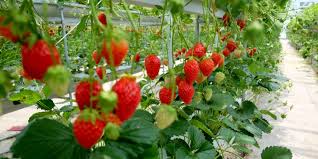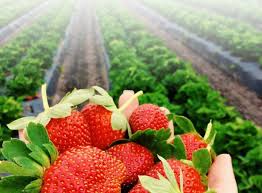Strawberry farming is an exciting venture that involves growing delicious and vibrant red berries. Farmers engage in this agricultural activity to cultivate these sweet fruits, which are not only tasty but also packed with essential nutrients. Let’s delve into the world of strawberry farming and explore the key aspects of this fruitful endeavor.
In strawberry farming, selecting the right variety is crucial. Different varieties thrive in various climates, so farmers often choose those that are well-suited to their specific region. The plants typically prefer well-drained soil with good sunlight exposure.
Farmers usually start the process by preparing the soil and planting strawberry runners. These runners, also known as daughter plants, are young shoots that develop from the main strawberry plant. They serve as the foundation for new strawberry plants and are carefully placed in rows to ensure optimal growth.
Watering plays a vital role in strawberry farming. These plants require consistent moisture, especially during the flowering and fruiting stages. Drip irrigation systems are commonly used to provide a controlled and efficient water supply to the strawberry plants, helping them thrive in a balanced environment.
To protect the delicate strawberries from weeds, farmers often employ mulching techniques. Mulch not only suppresses weeds but also helps retain moisture in the soil, reducing the need for excessive watering. This practice contributes to healthier and more robust strawberry plants.
Strawberry plants are sensitive to pests and diseases, making pest management an essential aspect of successful strawberry farming. Farmers employ various strategies, such as biological control and the use of organic pesticides, to safeguard their crops. Regular monitoring and early intervention are key to preventing potential damage.
One of the highlights of strawberry farming is the joyous moment of harvesting ripe, juicy berries. Harvesting is a delicate process that requires careful handling to avoid damaging the fragile fruits. Farmers often pick strawberries at their peak ripeness, ensuring maximum flavor and sweetness.
Post-harvest handling is crucial to preserve the quality of the strawberries. Proper storage conditions, such as refrigeration, help extend the shelf life of the berries and maintain their freshness. Many farmers also explore value-added options like making jams or selling fresh strawberries directly to consumers.
Strawberry farming is not only about cultivating a popular fruit; it’s also about fostering sustainable agricultural practices. Some farmers adopt organic methods, avoiding synthetic chemicals and prioritizing environmentally friendly approaches. This not only benefits the soil but also aligns with the growing consumer demand for organic and sustainable produce.
In addition, strawberry farming is a rewarding venture that requires careful planning, attention to detail, and a love for delicious, sun-kissed berries. From selecting the right variety to post-harvest handling, each step contributes to the success of this delightful agricultural pursuit. Whether on a small family farm or a larger commercial operation, strawberry farming offers a taste of nature’s sweetness and the satisfaction of nurturing a thriving crop.
Farmers often engage in continuous learning and innovation to enhance their strawberry farming practices. Staying updated on the latest advancements in crop management, pest control, and soil health allows them to adapt and improve their techniques over time. This commitment to knowledge ensures a more sustainable and productive strawberry farming experience.
Climate considerations play a significant role in strawberry farming success. While these berries generally thrive in temperate climates, advancements in greenhouse technology have enabled farmers to extend the growing season in areas with colder winters. Greenhouse cultivation provides a controlled environment, protecting the plants from adverse weather conditions and allowing for year-round production.
As part of good agricultural practices, crop rotation is commonly employed in strawberry farming. Alternating strawberry crops with other plants helps break pest and disease cycles, enriches the soil with diverse nutrients, and contributes to long-term soil health. This thoughtful approach minimizes the risk of soil depletion and promotes a more balanced and sustainable farming ecosystem.
In some regions, cooperative farming initiatives have gained popularity among strawberry growers. Collaborative efforts enable farmers to share resources, knowledge, and market access. By working together, they can negotiate better prices, collectively invest in advanced equipment, and support each other in overcoming challenges, fostering a sense of community within the strawberry farming sector.
The popularity of farmers’ markets and direct-to-consumer sales has provided strawberry farmers with new avenues to showcase and sell their produce. Many farmers embrace this opportunity to connect with consumers, offering fresh, locally grown strawberries and sharing their passion for sustainable agriculture. Direct sales not only benefit farmers financially but also create a direct link between producers and consumers, fostering a deeper appreciation for the fruits of strawberry farming.
However, strawberry farming is a dynamic and evolving endeavor that goes beyond the simple act of growing berries. It involves a combination of science, art, and a deep understanding of the natural world.
Successful strawberry farmers blend traditional wisdom with modern techniques, creating a harmonious balance that ensures the continued delight of savoring those luscious red fruits while contributing to the broader landscape of sustainable agriculture.
Read Also: Burmese Cat Breed (Felis catus) Description and Complete Care Guide
How to Start Strawberry Farming

Starting strawberry farming can be a rewarding venture, and here’s a simplified guide to help you embark on this journey:
1. Research and Planning: Begin by researching suitable strawberry varieties for your climate and soil conditions. Consider factors such as temperature, sunlight, and soil type. Create a detailed plan that includes the layout of your farm, the number of plants, and necessary resources.
2. Land Preparation: Choose a well-drained area with good sunlight exposure. Prepare the soil by removing weeds and incorporating organic matter. Conduct a soil test to determine nutrient levels and make amendments as needed.
3. Selecting Strawberry Plants: Purchase healthy strawberry runners or young plants from reputable nurseries. Choose varieties that are well-suited to your region and farming goals. Popular varieties include June-bearing, everbearing, and day-neutral strawberries.
4. Planting: Plant strawberry runners in rows, leaving enough space between plants for proper growth. Ensure the crown (the part where the roots meet the leaves) is at the soil surface. Water the plants thoroughly after planting.
5. Irrigation: Implement a reliable irrigation system. Strawberries need consistent moisture, especially during flowering and fruiting. Drip irrigation is commonly used to provide a controlled and efficient water supply.
6. Mulching: Apply mulch around the strawberry plants to suppress weeds, retain soil moisture, and prevent soil splashing on the berries. Straw, pine straw, or plastic mulch are commonly used options.
7. Fertilization: Follow a fertilization schedule based on the nutrient needs of strawberries. Consider using organic fertilizers or slow-release fertilizers to promote healthy plant growth.
8. Pest and Disease Management: Regularly monitor for pests and diseases. Implement integrated pest management strategies, including the use of beneficial insects and organic pesticides. Early detection and intervention are crucial to preventing crop damage.
9. Harvesting: Harvest strawberries when they are fully ripe. Gently pick the berries to avoid damage. Harvesting frequency depends on the strawberry variety; for instance, June-bearing strawberries have a concentrated harvest period, while everbearing varieties produce fruit throughout the season.
10. Post-Harvest Handling: Handle harvested strawberries with care to avoid bruising. Store them in cool temperatures, ideally refrigerated, to maintain freshness. Consider exploring value-added options, such as making jams or selling fresh strawberries directly to consumers.
11. Continuous Learning: Stay informed about the latest advancements in strawberry farming. Attend workshops, join farming communities, and learn from experienced growers. Adapt your practices based on your experiences and newfound knowledge.
Remember, starting a strawberry farm requires dedication, attention to detail, and a willingness to learn. By following these basic steps and continuously refining your approach, you can cultivate a successful and fruitful strawberry farming venture.
Read Also: Himalayan Cats (Felis catus) Description and Complete Care Guide
Importance of Strawberry Farming

The importance of strawberry farming extends beyond its role as a source of delicious berries. Here are several key aspects highlighting the significance of strawberry farming:
1. Nutritional Value: Strawberries are rich in essential nutrients, including vitamin C, manganese, and antioxidants. Incorporating these berries into diets contributes to overall health and well-being.
2. Economic Impact: Strawberry farming is a significant contributor to the agricultural economy. It provides income for farmers, employment opportunities, and supports related industries such as transportation, packaging, and marketing.
3. Diversification of Agriculture: Strawberry farming diversifies the range of crops cultivated, promoting agricultural sustainability. Crop rotation with strawberries can break pest and disease cycles, contributing to healthier soils.
4. Sustainable Agriculture: Many strawberry farmers adopt sustainable farming practices, such as organic cultivation, which minimizes the use of synthetic chemicals. This approach benefits the environment, reduces ecological impact, and aligns with consumer preferences for sustainable produce.
5. Direct-to-Consumer Connection: Strawberry farming often involves direct sales to consumers through farmers’ markets or on-farm stands. This direct connection enhances consumer awareness, appreciation for locally grown produce, and supports a sense of community.
6. Community Engagement: Strawberry farms can become focal points for community engagement. They offer educational opportunities for schools, local events, and agricultural tourism, fostering a greater understanding of farming practices.
7. Global Trade: Strawberries are traded globally, contributing to international commerce. This exchange allows regions with favorable growing conditions to supply strawberries to areas where they might not be readily available due to climate constraints.
8. Research and Innovation: Strawberry farming drives research and innovation in agriculture. Ongoing efforts to develop new varieties, improve cultivation techniques, and address pest and disease challenges benefit not only strawberry farmers but also contribute to advancements in agriculture as a whole.
9. Health and Wellness: The nutritional benefits of strawberries contribute to improved public health. Incorporating these fruits into diets supports a balanced and nutrient-rich lifestyle, potentially reducing the prevalence of diet-related health issues.
10. Culinary and Food Industry: Strawberries play a significant role in the culinary world. They are used in a variety of dishes, from desserts to salads, adding flavor, color, and nutritional value. This culinary versatility contributes to the popularity of strawberries in the food industry.
In summary, the importance of strawberry farming encompasses nutritional benefits, economic impact, sustainability, community engagement, and contributions to global trade. As a versatile and valuable crop, strawberries contribute to the overall well-being of individuals, communities, and the agricultural industry.
Read Also: Comminutor and Grinder Process
